The fusion of dairy-free and keto dietary approaches has forged a popular lifestyle choice for many seeking the benefits of a low-carb, high-fat diet without dairy. This convergence caters to those who are either lactose intolerant, have a dairy allergy, or simply choose to eliminate dairy for personal or health reasons.
Dairy-free keto recipes offer an array of creative and satisfying meals while adhering to the macronutrient requirements necessary to maintain a state of ketosis.
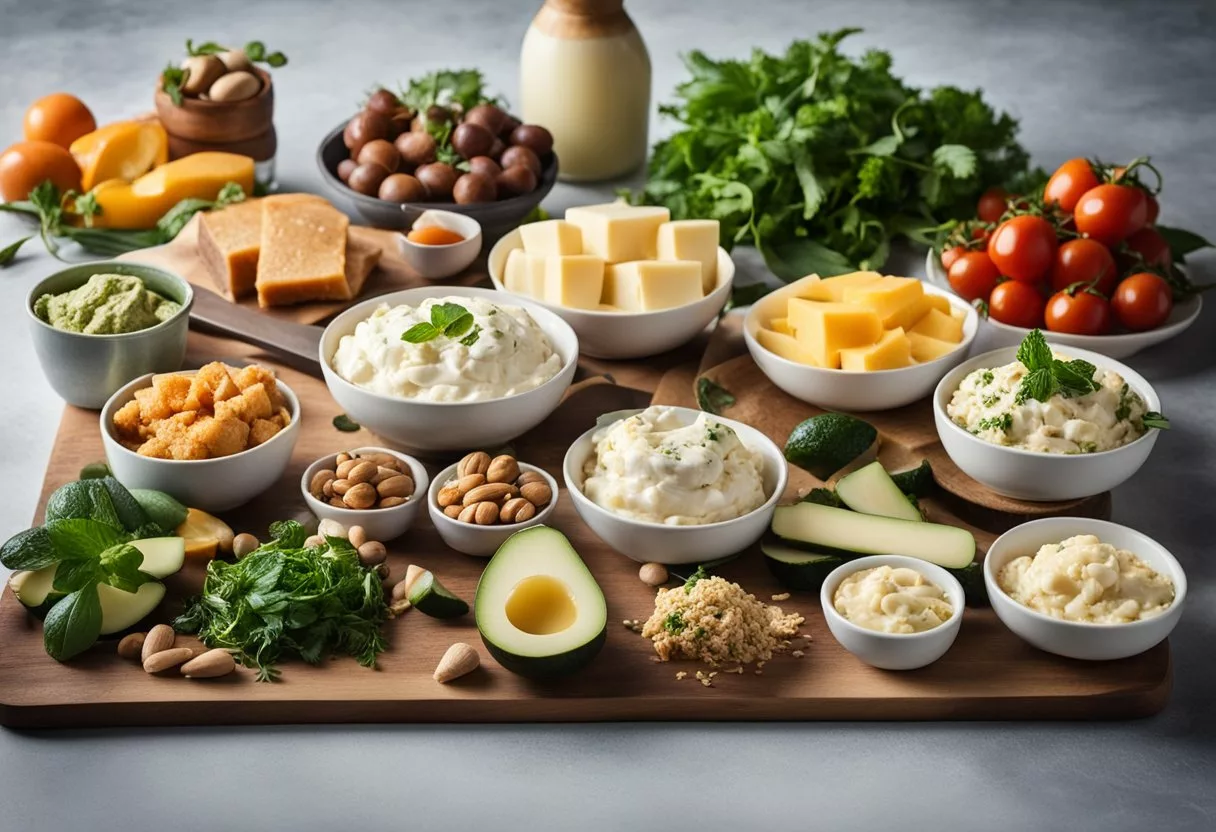
Transitioning to a dairy-free ketogenic lifestyle involves finding suitable substitutes for dairy products that are often staples in traditional keto recipes. By using alternatives such as coconut cream, almond milk, and other plant-based options, it’s possible to enjoy a rich variety of meals.
Furthermore, by incorporating these alternatives, individuals can explore a wide range of flavors and textures that might not be present in standard keto dishes. Finding a balance between the restrictions of a dairy-free diet and the high-fat, low-carb keto principles requires careful meal planning and a solid understanding of the nutritional content within recipes.
Key Takeaways
- Dairy-free keto combines the high-fat, low-carb principles of the ketogenic diet with a dairy exclusion.
- Proper planning and ingredient substitution are key to maintaining ketosis and a satisfying menu.
- Knowledge of nutritional content assists in making informed dietary decisions within this lifestyle.
Understanding Dairy-Free Keto
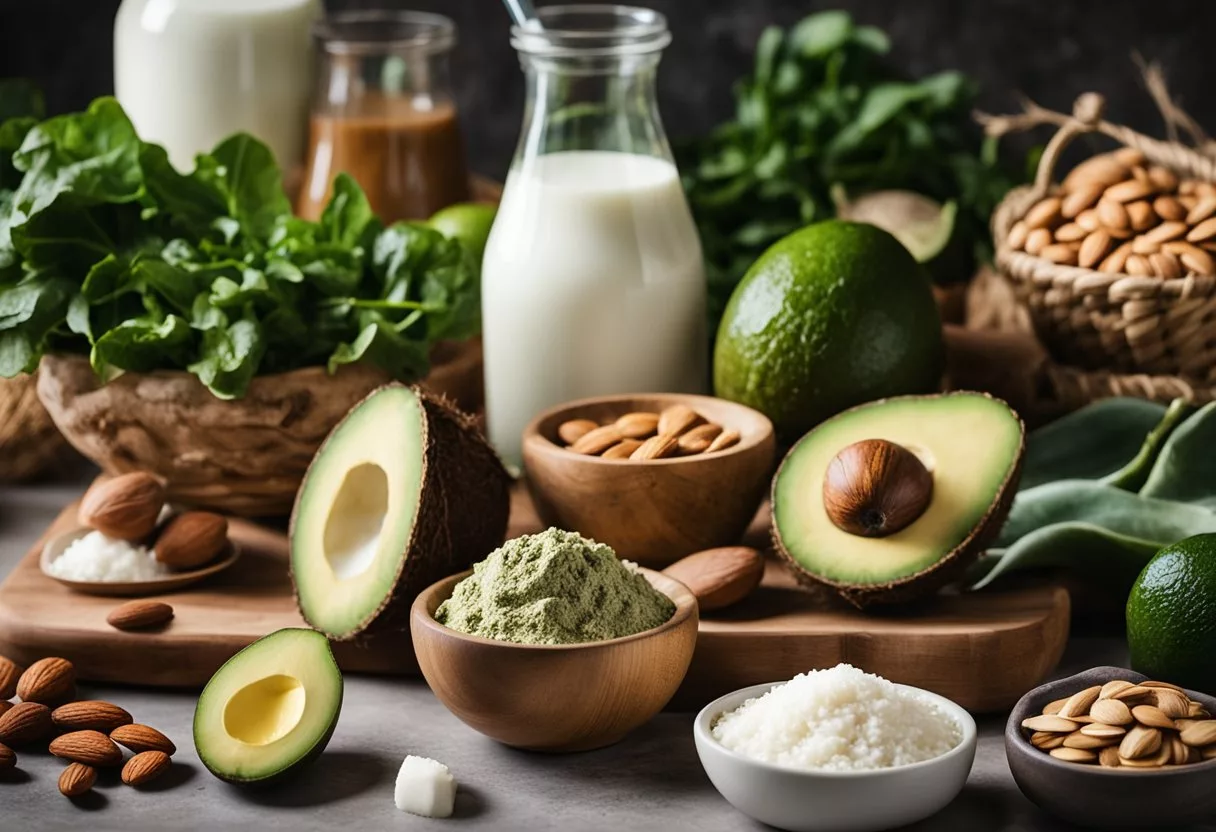
Navigating a ketogenic diet without dairy may seem challenging given dairy’s prevalence in traditional keto recipes. This section explores the keto diet’s fundamentals, the advantages of a dairy-free approach, and the substitutes that can keep dairy off the menu without compromising on taste or nutrition.
The Basics of a Keto Diet
A ketogenic diet is a high-fat, moderate-protein, and low-carbohydrate eating plan. The objective is to enter a metabolic state called ketosis, where the body uses fat as the primary energy source instead of glucose. Net carbs (total carbohydrates minus fiber) are typically limited to less than 50 grams per day to maintain ketosis. While traditional keto diets often include dairy products like cheese and butter for their high-fat content, it’s entirely possible to adhere to this regimen without them.
Benefits of Dairy-Free Keto
Choosing a dairy-free ketogenic diet can be beneficial for those with lactose intolerance or milk protein sensitivities, as avoiding dairy eliminates the discomfort associated with consuming lactose or casein. Additionally, a dairy-free keto diet can help reduce inflammation for some individuals and may lead to a broader consumption of nutrient-rich, plant-based foods.
Dairy Substitutes in Keto
In a dairy-free keto diet, several substitutes can replace common dairy products. Unsweetened almond milk or coconut milk can stand in for milk, while coconut cream can serve as a heavy cream alternative. Dairy-free cheeses made from nuts or nutritional yeast can mimic the flavor and texture of traditional cheese. For butter, one can opt for plant-based spreads, coconut oil, or other high-fat, low-carb oils. These substitutes help maintain the balance of fats necessary for the diet without the inclusion of dairy.
Dairy-Free Keto Ingredients
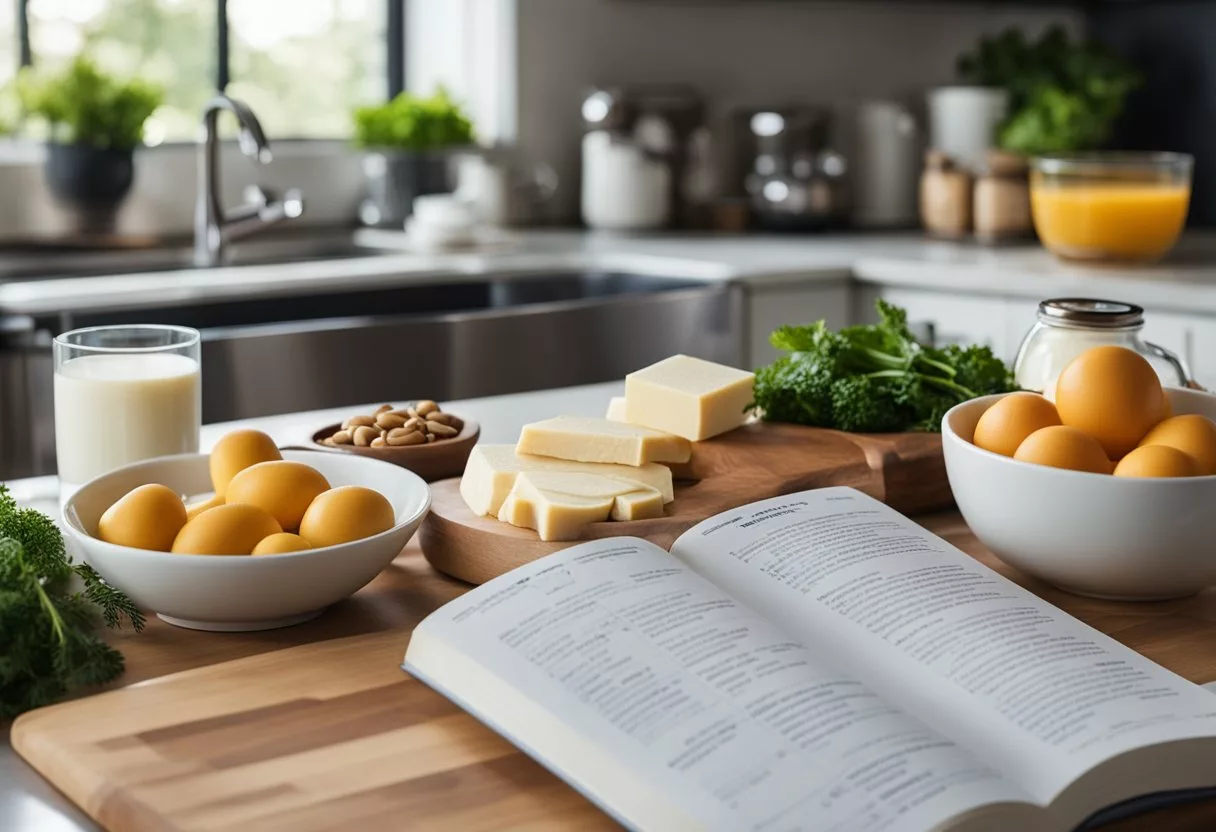
Crafting delicious and nutritious dairy-free keto recipes hinges on selecting the right ingredients rich in quality fats and proteins, along with low-carb vegetables and nuts. These components are essential to maintain ketosis without the inclusion of dairy.
Proteins and Fats
Proteins play a pivotal role in a dairy-free keto diet. Opt for grass-fed meats, wild-caught seafood, and eggs, each a valuable source of protein and other nutrients. They can act as the main component in meals, providing the required protein intake without any dairy.
- Grass-fed beef and poultry
- Wild-caught fish like salmon and tuna
- Eggs from pasture-raised hens
Dairy-Free Fats and Oils
Healthy fats are crucial for a keto diet. Some of the best dairy-free sources include olive oil and coconut oil. Additionally, ghee, which is clarified butter with milk solids removed, may be suitable for those avoiding dairy due to lactose or casein sensitivities.
- Olive oil: A heart-healthy fat perfect for salads and low-heat cooking.
- Coconut oil: Ideal for baking and high-heat cooking.
- Ghee: Offers a rich, buttery flavor suitable for those who can tolerate clarified dairy.
Low-Carb Vegetables and Nuts
While most vegetables are permitted on a keto diet, it is important to focus on those with lower carbohydrate content to keep within the daily carb limit.
Low-Carb Vegetables:
- Leafy greens like spinach and kale
- Cruciferous vegetables such as broccoli and cauliflower
Nuts: Nuts are a great source of fats and can be consumed in moderation.
- Almonds, walnuts, and macadamia nuts
Other Dairy-Free Essentials
Dairy replacements such as nut milks, coconut milk, and coconut cream provide the creaminess and fat content one misses from dairy products. Berries offer a touch of sweetness while keeping carbs in check.
- Almond milk and coconut milk: For smoothies and baking.
- Coconut cream: For rich, creamy sauces and desserts.
- Berries: Include a variety like strawberries and blueberries for moderate sweetness.
Dairy-Free Keto Meal Planning
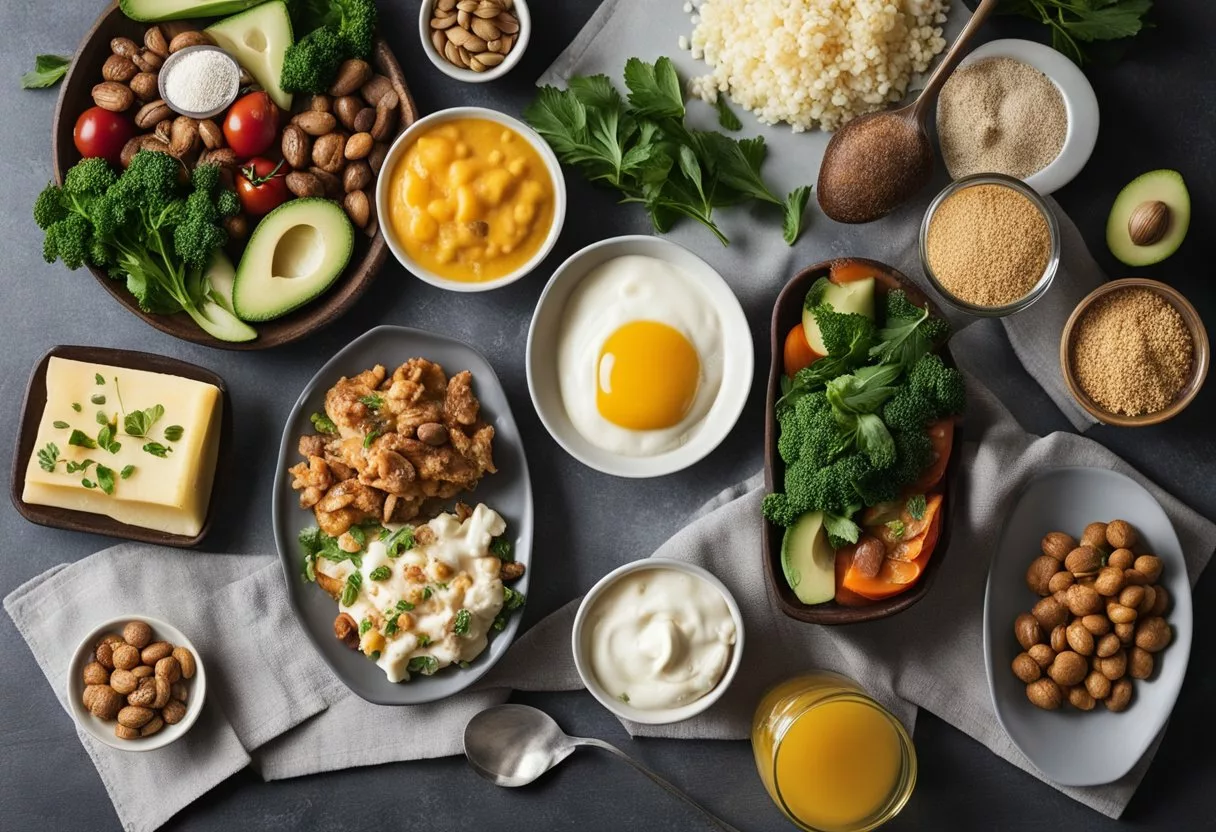
Adhering to a dairy-free keto diet requires careful meal planning to ensure a balanced intake of fats, proteins, and low-carb vegetables. Planning meals around whole, unprocessed foods like meats, eggs, and seafood helps maintain ketosis while avoiding dairy.
Breakfast Ideas
When choosing breakfast options, low-carbohydrate, high-fat foods are paramount. One might consider starting the day with:
- Bacon and Eggs: A classic keto breakfast, providing high-quality protein and fat.
- Avocado Smoothie: Blended with full-fat coconut milk for a quick, satiating meal.
Meal prep tip: Pre-cook bacon and boil eggs in advance for easy morning assembly.
Lunch Recipes
For lunch, protein-rich meals ensure sustained energy levels throughout the day. Some dairy-free keto lunches include:
- Chicken Salad: Using avocado mayo, served over a bed of leafy greens.
- Beef Lettuce Wraps: Thinly sliced beef wrapped in lettuce with keto-friendly condiments.
Prep ahead: Cook meats in batches and portion for the week to simplify meal preparation.
Dinner Options
Dinner can be both satisfying and dairy-free with keto-friendly options such as:
- Grilled Fish: Seasoned with lemon and herbs, paired with a side of asparagus.
- Stir-Fried Shrimp: With a variety of low-carb vegetables in coconut oil.
Cooking tip: Utilize different herbs and spices to add variety to seafood dishes without adding carbs.
Keto Snacks and Sides
Snacking and side dishes can complement main courses by adding fiber and texture. Consider these:
- Bacon Wrapped Green Beans: A savory snack providing both crunch and fat.
- Cauliflower Rice: A versatile side that can be flavored in countless ways to accompany any meal.
Snack idea: Preparing keto-friendly dips such as guacamole for vegetable sticks can help curb midday hunger pangs.
Dairy-Free Keto Cooking Techniques
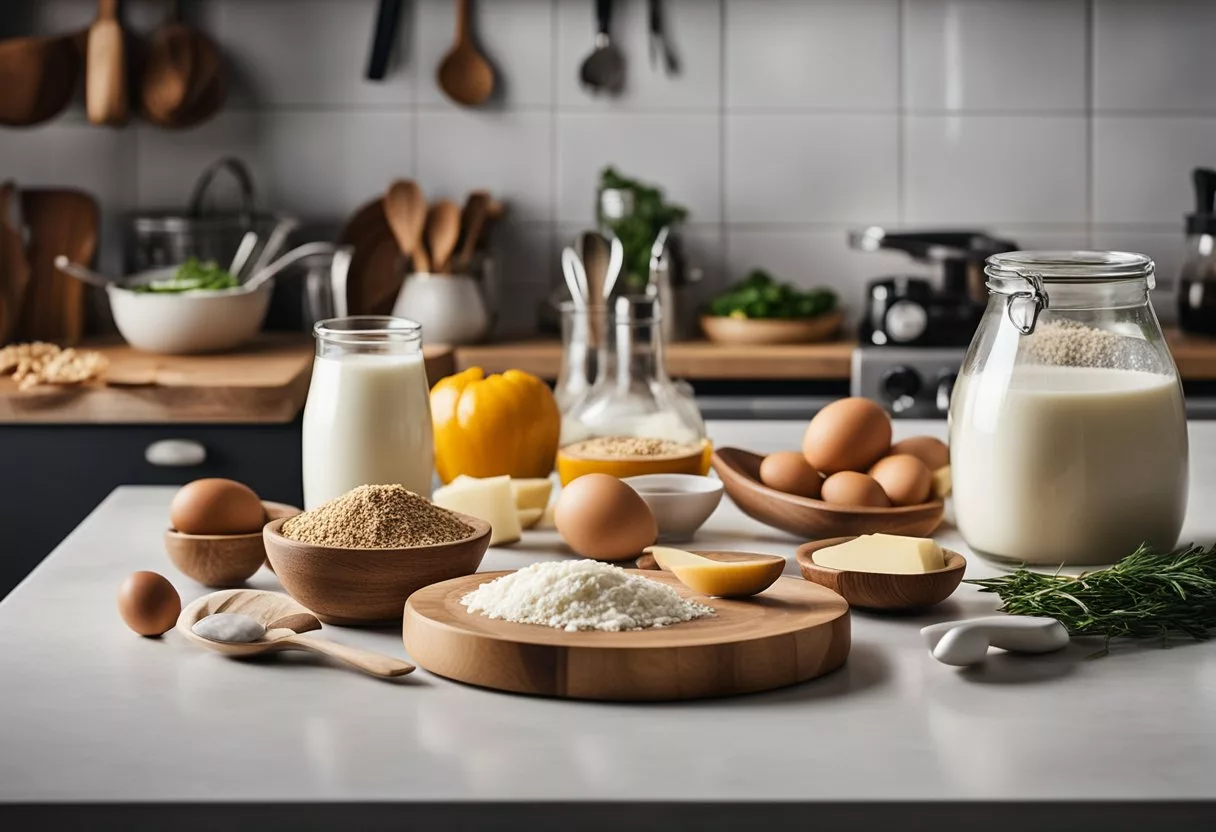
When preparing dairy-free keto dishes, one must focus on employing alternative ingredients and methods that retain the flavor and texture of traditional recipes. These techniques ensure that meals are not only compliant with dietary restrictions but also delicious and satisfying.
Creating Dairy-Free Sauces and Dressings
Dairy-free keto cooking necessitates innovative approaches for sauces and dressings. Substitutions are pivotal, with coconut cream often taking the place of heavy cream to add richness. For example, one can thicken sauces with almond flour or coconut flour, which are both keto-friendly and gluten-free. When creating dairy-free dressings, olive oil or avocado oil can serve as the base, while adding lemon juice or vinegar provides the necessary acidity. Herbs and spices contribute to the flavor without additional carbs.
Baking Without Dairy
Baking on a dairy-free keto diet involves the use of non-dairy fats such as coconut oil or ghee, if not strictly avoiding all dairy, including butter derivatives. Almond flour and coconut flour are excellent flour substitutes, providing structure to baked goods while maintaining a low-carb profile. To create moist textures typical of dairy-containing baked goods, items like almond milk or coconut milk can be incorporated. Paleo and Whole30 options might include using natural sweeteners like monk fruit or stevia.
Sautéing and Frying
For sautéing and frying in dairy-free keto recipes, chefs utilize oils with high smoke points, such as avocado oil or coconut oil, which are also Whole30 compliant. They must avoid traditional dredging ingredients like wheat flour, instead opting for a mixture of almond and coconut flours for breading. These alternatives not only adhere to the keto, gluten-free, and often paleo guidelines but also deliver the desired crispness and flavor to the dish.
Popular Dairy-Free Keto Recipes
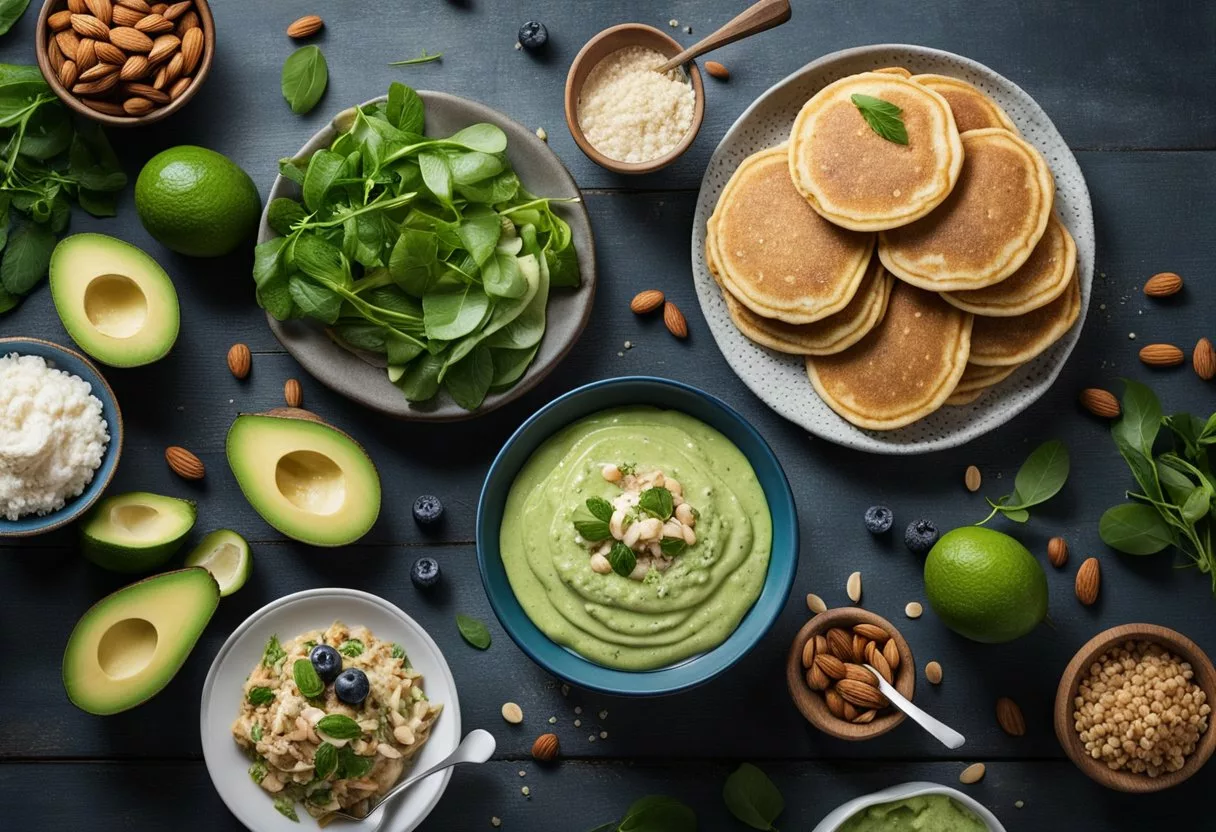
Navigating a dairy-free keto lifestyle can be straightforward with a repertoire of go-to recipes. From satisfying main courses to delightful desserts, these dairy-free keto options showcase how one can maintain a low-carb diet without reliance on dairy products.
Main Courses
In the realm of dairy-free keto main courses, options abound that cater to a wide range of tastes. Keto chicken salad and chicken tenders become staples for a quick protein fix, while pork chops and stir-fry dishes provide ample opportunities to incorporate a variety of vegetables and flavors. Recipes often feature substitutions like coconut cream or almond milk to create rich, satisfying sauces without dairy.
- Keto Meatballs: Made with almond flour instead of breadcrumbs and served with zucchini noodles.
- Instant Pot Beef Stew: Hearty and flavorful with chunks of beef, low-carb vegetables, and a thick, savory broth.
- Green Bean Casserole: A classic reimagined with a dairy-free creamy mushroom sauce and a crispy almond topping.
- Meatloaf: Bound with egg and finely ground pork rinds, keeping it low in carbs and high in flavor.
- Cauliflower Mash: A creamy and comforting side dish, perfect to pair with any keto-friendly protein.
Dairy-Free Keto Desserts
A dairy-free keto diet does not mean the end of desserts. With natural sweeteners and creative use of dairy alternatives, one can enjoy decadent sweets.
- Key Lime Pie Fat Bombs: A refreshing treat with a coconut oil and avocado base, sweetened with a keto-friendly sweetener.
- Keto Lemon Bars: Feature an almond flour crust and a tangy lemon custard made with eggs and sweetener.
Quick and Easy Meals
For those short on time, dairy-free keto doesn’t have to be complicated. There are countless quick and simple meals that satisfy cravings without dairy.
- Keto Bacon Coleslaw: A crunchy and tangy side dish that comes together in minutes.
- Burger: Serve on lettuce wraps or keto buns made from almond or coconut flour.
- Soup: A variety of soups such as pumpkin or chicken soup that use coconut cream for richness.
Comfort Foods without Dairy
Yes, even classic comfort foods can be enjoyed dairy-free and low-carb. With simple substitutes, one can still enjoy the taste of their favorites.
- Pizza: A cheese-free crust topped with marinara, meats, and veggies.
- Pasta: Spiralized vegetables or shirataki noodles provide the base for hearty sauces like Bolognese.
- Bread: Keto bread recipes use alternatives like almond flour and yeast for a satisfying texture.
Adapting Classic Recipes to Dairy-Free Keto

When following a ketogenic diet with dairy restrictions, one can still enjoy their favorite dishes by making simple substitutions. It’s both practical and satisfying to modify traditional recipes to fit dairy-free keto parameters, ensuring those with allergies or intolerances aren’t left out.
Dairy-Free Twists on Traditional Favorites
Classic keto staples often rely on dairy for texture and flavor, but they can be adapted using alternative ingredients. For peanut butter cookies, swapping out butter for coconut oil can provide the necessary fats without dairy. Natural peanut butter is typically free from added sugars, making it keto-friendly. Queso dips can be reimagined with nutritional yeast and a dairy-free milk alternative to give the creamy, cheesy texture and flavor, while cream cheese can be replaced with dairy-free varieties derived from almond or cashew nuts for bagels or dips.
Replacing dairy in ketogenic recipes is straightforward with these suggestions:
- Butter: Use ghee or coconut oil.
- Cream Cheese: Opt for almond-based or cashew-based alternatives.
- Yogurt: Select coconut or almond milk yogurt.
Creating granola bars without the added sugars and conventional grains is achievable by using a combination of nuts and seeds bound together with a sweetener like erythritol or stevia and using oil to replace any butter.
International Cuisine Dairy-Free Keto Style
Exploring international cuisine on a dairy-free ketogenic diet opens up a world of flavors. Dishes that typically include creamy sauces or cheese can be enjoyed by using substitutes that align with dairy-free keto guidelines. For example, Greek tzatziki can be made with dairy-free yogurt, while Italian favorites, such as alfredo sauce, can incorporate coconut cream as a stand-in for heavy cream.
Dairy-free ketogenic cooking doesn’t have to limit cultural culinary experiences. There are unique ways to craft them to suit dietary needs:
- Italian: Substitute traditional cheeses with nutritional yeast for a cheesy flavor without dairy.
- Mexican: Create a dairy-free queso dip by blending soaked nuts for richness, adding lemon juice for tanginess, and mixing in spices for authentic flavor.
Attention should still be given to ensure that these substitutions not only meet keto and dairy-free requirements but also align with gluten-free needs if necessary.
Health Considerations and Nutritional Insights
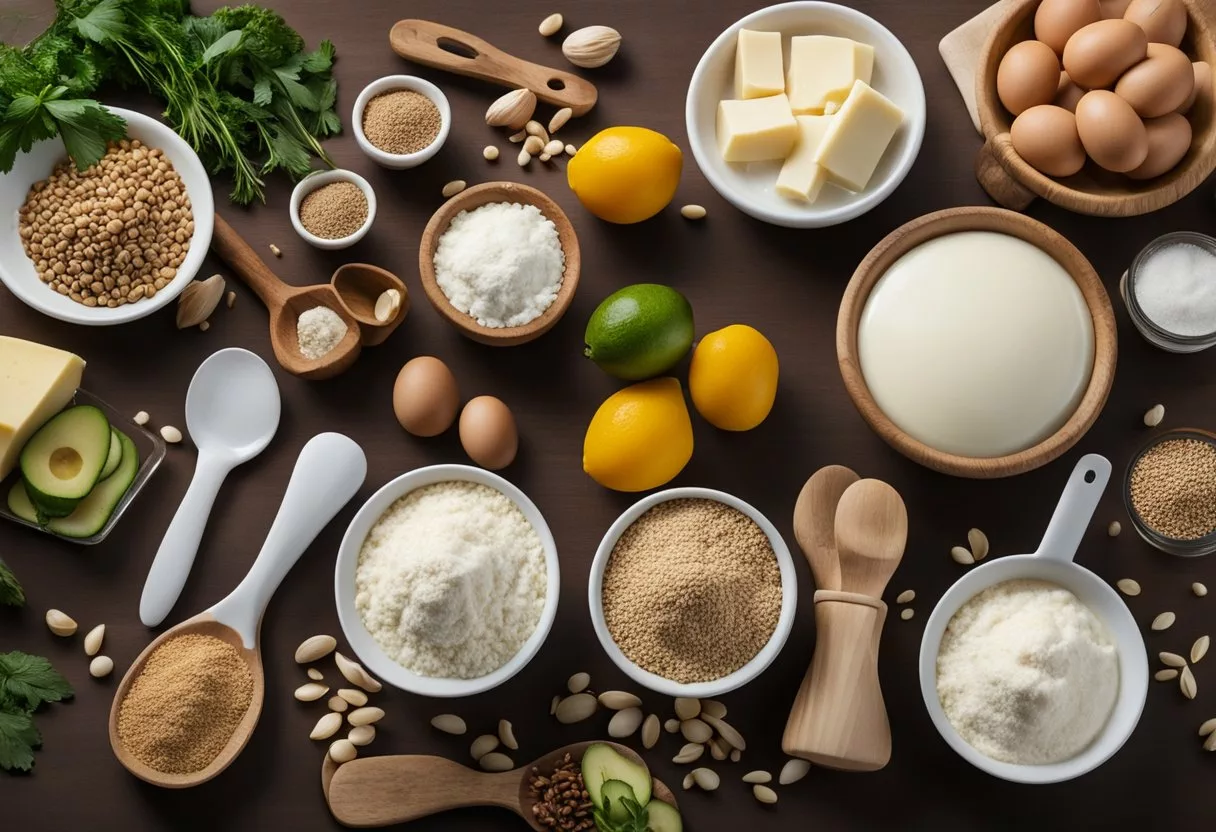
Dairy-free keto recipes cater to persons managing food sensitivities, looking for weight loss benefits, and adapting the diet to various lifestyles and conditions. Nutritional balance is maintained by focusing on high-quality proteins and fats while minimizing net carbs.
Managing Food Sensitives
For individuals with lactose intolerance or dairy allergies, dairy-free keto recipes avoid milk sugars and dairy proteins that can cause digestive distress and immune responses. Individuals following a dairy-free keto diet typically replace traditional dairy products with alternative fat sources such as coconut cream, nut milks, and avocado to ensure they still consume adequate fats without dairy’s potential adverse effects.
Weight Loss and Metabolic Health
A dairy-free keto diet may assist in weight loss by reducing insulin secretion and stabilizing blood sugar levels, benefits that align with the dietary goals of individuals with type 2 diabetes. High in protein and fat, these recipes support satiety and may prevent overeating. By focusing on net carbs—total carbohydrates minus fiber—individuals can manage their carbohydrate intake more effectively.
Keto for Different Lifestyles and Conditions
Keto recipes can be adapted to suit different dietary needs, including those of a growing baby, by ensuring nutrient-dense food choices. However, it is crucial to consult with healthcare professionals to tailor the diet appropriately, especially in sensitive populations where nutrient requirements are unique, such as in pregnant women or individuals with specific health conditions.
Frequently Asked Questions
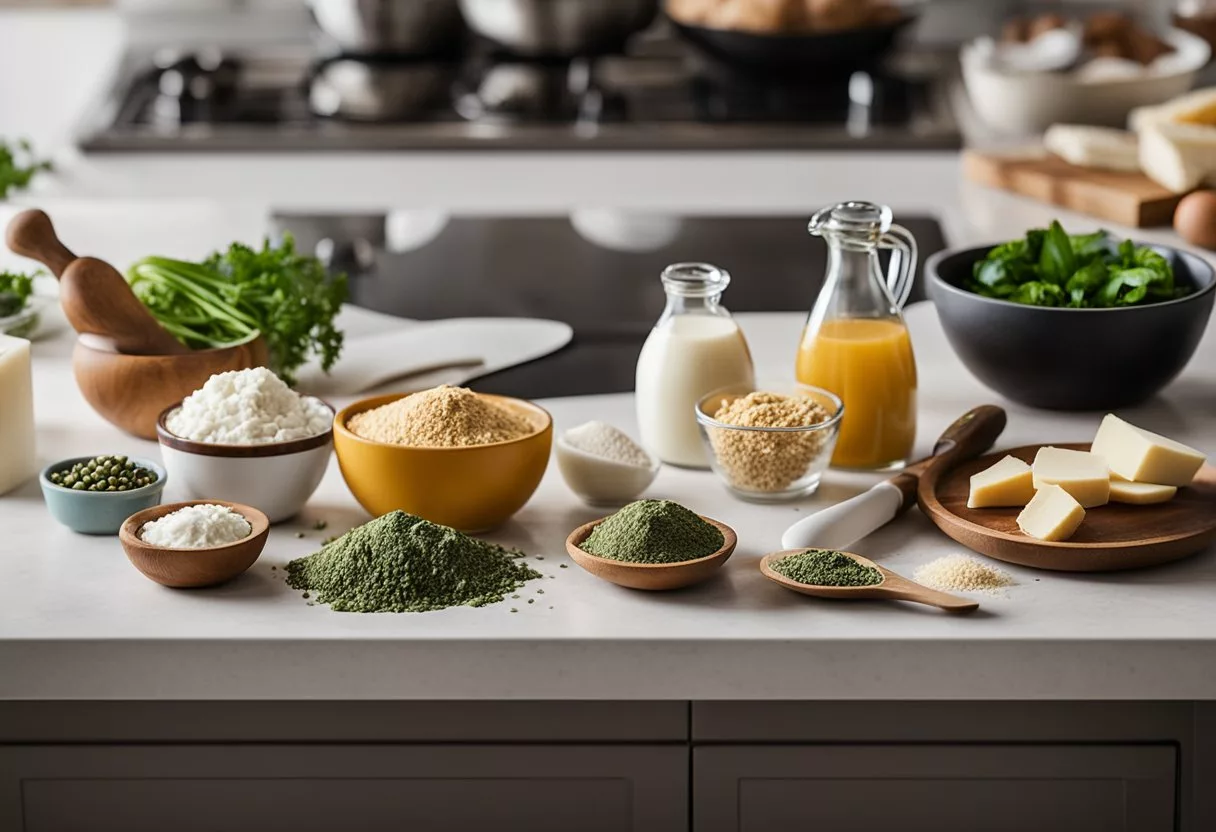
Navigating a dairy-free ketogenic diet can lead to many questions about meal planning and snacking. Below are answers to common queries that arise when someone embraces this lifestyle.
What are some satisfying dairy-free snack options for someone following a ketogenic diet?
Individuals can enjoy snacks like avocado slices, nuts, and seeds, which are high in healthy fats and low in carbs. Additionally, coconut yogurt and olives are great dairy-free, keto-friendly choices.
Can you suggest a meal plan that is both dairy-free and keto-friendly?
A meal plan might include a spinach and mushroom omelet for breakfast, a kale salad with grilled chicken for lunch, and zucchini noodles with a dairy-free pesto sauce for dinner. Snacks can be a handful of macadamia nuts or celery with almond butter.
What are some delightful dairy-free dessert recipes that comply with keto dietary guidelines?
For desserts, one can prepare almond flour brownies sweetened with stevia, or a coconut milk-based chocolate mousse. These satisfy sweet cravings without adding dairy or excess carbohydrates.
Are there any comprehensive lists of dairy-free foods that are also suitable for a keto diet?
Yes, comprehensive lists often include leafy greens, high-fat meats, fish, eggs, and dairy substitutes like nut milks or dairy-free cheeses that are low in carbs to fit within keto parameters.
What breakfast options are available that adhere to both dairy-free and keto lifestyle choices?
Breakfast options include chia seed puddings made with almond milk, flaxseed pancakes without dairy, or a simple combination of smoked salmon and avocado.
How can I incorporate gluten-free and dairy-free ingredients into keto recipes without compromising taste?
By using almond, coconut, or other nut flours, one can create gluten-free and dairy-free baked goods. Spices, herbs, and nutritional yeast can add flavor to recipes without the need for gluten or dairy.
